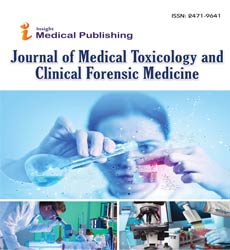Toxicological Profiling of Novel Psychoactive Substances: Emerging Challenges in Forensic Medicine
Arvind Menon
Department of Forensic Medicine and Toxicology, All India Institute of Medical Sciences, New Delhi, India
Published Date: 2025-02-28DOI10.36648/2471-641.11.1.157
Received date: February 03, 2025, Manuscript No. ipjmtcm-25-20806; Editor assigned date: February 05, 2025, Pre QC No. ipjmtcm-25-20806 (PQ); Reviewed date: February 17, 2025, QC No. ipjmtcm-25-20806; Revised date: February 22, 2025, Manuscript No. ipjmtcm-25-20806 (R); Published date: February 28, 2025, DOI: 10.36648/2471-641.11.1.157.
Citation: Menon A (2025) Toxicological Profiling of Novel Psychoactive Substances: Emerging Challenges in Forensic Medicine. J Med Toxicol Clin Forensic: Vol.11 No. 1: 157.
Introduction
Novel Psychoactive Substances (NPS) have rapidly emerged as a significant concern for forensic medicine and public health. Commonly referred to as â??designer drugsâ?ÃÂ or â??legal highs,â?ÃÂ these synthetic compounds are often structurally modified versions of controlled substances, developed to mimic the effects of cannabis, stimulants, hallucinogens, and opioids. Their growing popularity stems from ease of access via online markets, evasion of drug legislation, and appeal to recreational users seeking new experiences. However, the diversity, potency, and unpredictability of NPS pose major challenges in toxicological profiling, clinical management, and forensic investigation. NPS comprise a wide range of chemical classes, including synthetic cannabinoids, cathinones, phenethylamines, tryptamines, piperazines, and novel opioids. Each class exhibits unique pharmacodynamics and toxicological profiles, making standardized characterization difficult. For instance, synthetic cannabinoids often act as potent full agonists at CB1 receptors, surpassing the effects of natural cannabis, while cathinones mimic stimulant properties but with unpredictable sympathomimetic toxicity [1].
Description
The pharmacological mechanisms of NPS are highly variable. Synthetic cannabinoids modulate endocannabinoid pathways, leading to psychotropic and cardiovascular effects. Synthetic cathinones act as monoamine reuptake inhibitors or releasers, producing stimulant effects akin to amphetamines. Novel opioids interact with µ-opioid receptors, carrying a high risk of respiratory depression. Hallucinogenic NPS, such as NBOMe derivatives, act as potent 5-HT2A receptor agonists. The unpredictability of receptor binding affinity and potency leads to unexpected toxic effects, often exceeding those of classical drugs of abuse. The clinical presentation of NPS intoxication is heterogeneous, ranging from mild agitation to life-threatening organ failure [2]. Common features include tachycardia, hypertension, seizures, hyperthermia, psychosis, and acute kidney injury. Synthetic cannabinoids have been linked to psychotic episodes and myocardial infarction, while cathinones are associated with severe agitation, rhabdomyolysis, and serotonin syndrome. Novel opioids, particularly fentanyl analogues, are notorious for causing sudden respiratory arrest even at microgram doses. Such variability makes clinical diagnosis and management highly challenging in emergency and forensic settings [3]. One of the most pressing forensic challenges is the analytical detection of NPS. Standard toxicology screens often fail to identify these compounds due to their constantly evolving structures and lack of reference standards. Advanced techniques such as Liquid Chromatography-Tandem Mass Spectrometry (LC-MS/MS), Gas Chromatography-Mass Spectrometry (GC-MS), and High-resolution Mass Spectrometry (HRMS) are essential for reliable detection. However, the high cost, limited accessibility, and need for specialized expertise hinder widespread adoption, leaving many forensic laboratories unprepared to keep pace with NPS trends [4]. NPS are increasingly implicated in medico-legal casework, including sudden deaths, impaired driving, and violent behavior. Postmortem examinations often reveal nonspecific findings such as pulmonary edema, cerebral edema, and visceral congestion, necessitating toxicological confirmation. In fatal opioid-related NPS cases, blood and tissue analysis often uncovers fentanyl analogues or synthetic benzodiazepines. Establishing causality in NPS-related deaths remains complex, as poly-drug use, metabolic instability, and postmortem redistribution frequently confound interpretation. Forensic toxicologists must therefore rely on multidisciplinary approaches combining circumstantial evidence, toxicological analysis, and autopsy findings. The legal regulation of NPS is complicated by their rapid turnover and structural variability. Many jurisdictions adopt â??blanket bansâ?àor analogue legislation to criminalize entire classes of substances [5].
Conclusion
Novel psychoactive substances represent one of the most pressing challenges in contemporary forensic medicine. Their chemical diversity, unpredictable pharmacology, and rapid evolution make toxicological profiling both complex and urgent. Clinically, NPS intoxication presents with severe, sometimes fatal outcomes, while forensically, their detection and interpretation require advanced analytical methods and multidisciplinary collaboration. Addressing the NPS crisis requires coordinated global efforts in regulation, toxicological surveillance, and scientific innovation. Strengthening laboratory capacity, legal frameworks, and public health awareness will be essential to mitigate the clinical and forensic burden of NPS in the coming decades.
Acknowledgement
None.
Conflict of Interest
None.
References
- Henry JA, Jeffreys KJ, Dawling S. (1992). Toxicity and deaths from 3, 4-methylenedioxymethamphetamine (" ecstasy"). Lancet340: 384-387.
Google Scholar Cross Ref Indexed at
- Kendrick WC, Hull AR, Knochel JP. (1977). Rhabdomyolysis and shock after intravenous amphetamine administration. Ann Intern Med86: 381-387.
Google Scholar Cross Ref Indexed at
- Vincenti F, Gregori A, Flammini M, Di Rosa F, Salomone, A. (2021). Seizures of new psychoactive substances on the Italian territory during the COVID-19 pandemic. Forensic Sci Int326: 110904.
Google Scholar Cross Ref Indexed at
- Jamey C, Kintz P, Martrille L, Raul JS. (2016). Fatal combination with 3-methylmethcathinone (3-MMC) and Gamma-Hydroxybutyric acid (GHB). J Anal Toxicol40: 546-552.
Google Scholar Cross Ref Indexed at
- Adamowicz P, Gieroà ? J, Gil D, Lechowicz W, Skulska A, et al. (2016). The prevalence of new psychoactive substances in biological material–a threeâ?Âyear review of casework in Poland. Drug Test Anal8: 63-70.

Open Access Journals
- Aquaculture & Veterinary Science
- Chemistry & Chemical Sciences
- Clinical Sciences
- Engineering
- General Science
- Genetics & Molecular Biology
- Health Care & Nursing
- Immunology & Microbiology
- Materials Science
- Mathematics & Physics
- Medical Sciences
- Neurology & Psychiatry
- Oncology & Cancer Science
- Pharmaceutical Sciences
